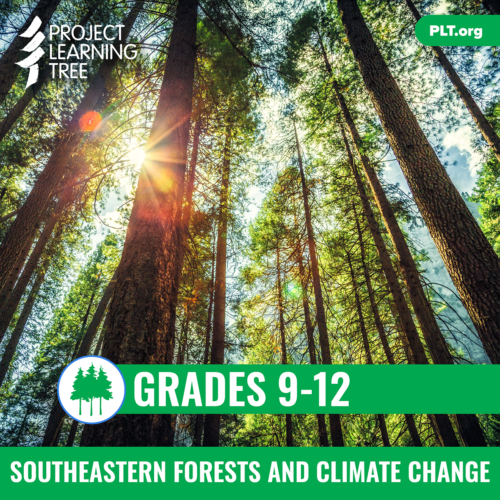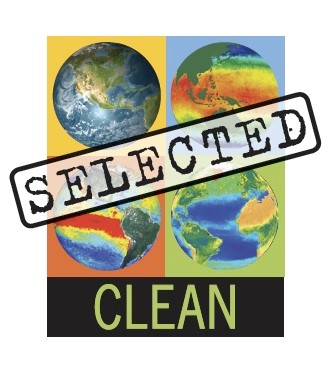 Project Learning Tree and the University of Florida developed this secondary module to help educators in the Southeast teach about
Project Learning Tree and the University of Florida developed this secondary module to help educators in the Southeast teach about
- climate change impacts on forest ecosystems
- the role of forests in sequestering carbon, and
- strategies for reducing greenhouse gas emissions and adapting to changing climatic conditions.
The module explores these concepts in 14 experiential activities (see details below) by using research related to the goals of PINEMAP—a regional research, education, and extension program focused on southern pine management and climate change.
While this resource was created with southeastern forests in mind, the lessons that comprise this module can be used with students across the United States.
Award-Winning
 Three activities from PLT’s Southeastern Forests and Climate Change were selected for inclusion in the Climate Literacy and Energy Awareness Network (CLEAN) collection of educational resources. CLEANet.org is an internationally recognized portal, funded by the National Science Foundation, the National Oceanic and Atmospheric Administration, and the Department of Energy. It features high-quality online resources that have passed rigorous review by scientists and educators.
Three activities from PLT’s Southeastern Forests and Climate Change were selected for inclusion in the Climate Literacy and Energy Awareness Network (CLEAN) collection of educational resources. CLEANet.org is an internationally recognized portal, funded by the National Science Foundation, the National Oceanic and Atmospheric Administration, and the Department of Energy. It features high-quality online resources that have passed rigorous review by scientists and educators.
This module also received 2 awards from the Association of Natural Resource Extension Professionals (ANREP):
- Outstanding Educational Materials — Long Publication: Gold Award
- Achievement Awards, Outstanding Team
Get Access Now |
Student Lessons
Activity 1 – Stepping through Climate Science
The activity provides an overview of the connections between forests and climate. Students create a timeline of climate science over the past 200 years and gather information from U.S. Forest Service video about climate mitigation and adaptation strategies for forests.
Activity 2 – Clearing the Air
Students learn about the scientific evidence supporting climate change, use this information to evaluate and improve conclusions some people might draw about climate change, and participate in a role-play to negotiate solutions. Through this activity, students explore the nature of science and better understand why there are various perspectives about climate changes.
Activity 3 – Atlas of Change
Students use the online resources, the Climate Change Atlas from the US Forest Service to explain the effects of climate change on the future distribution of suitable habitats for forest types, tree species, and bird species in the southeastern US.
Activity 4 – The Changing Forests
In small groups, students learn about research that is helping forest managers monitor and respond to climate change using new tools and management techniques.
Activity 5 – Managing Forest for Change
This activity allows students to explore the connection between forests, climate change impacts and management strategies for creating resilient forests. Students draw these connections in a system diagram, a tool that helps them see the system.
Activity 6 – Mapping Seed Sources
Students use growth data from loblolly pine forests to identify genetically different populations and project where trees with certain characteristics are likely to thrive in changing climatic conditions.
Activity 7 – Carbon on the Move
Students imagine they are a carbon atom and take part in a simulation that allows them to cycle through biological and physical systems. Group work and class discussions allow students to better understand carbon pools, quantities, fluxes, and residence time–with an emphasis on how human activities can affect where carbon goes.
Activity 8 – Counting Carbon
Students measure trees near their school and calculate the amount of carbon stored in individual trees. Students compare the carbon sequestration potential for land-use types in their state, compare this to the amount of carbon released by human activities, and then discuss forests’ ability to sequester atmospheric carbon.
Activity 9 – The Real Cost
Through a simulated shopping activity, students learn about life cycle assessments and the potential impact of their consumer choices on the environment. They explore questions such as: What factors do we use to make decisions about the products we buy? What are the hidden environmental costs of everyday items? Who should pay for these hidden costs?
Activity 10 – Adventures in Life Cycles Assessment
By performing a play through group presentations, students investigate life cycle assessment (LCA) data for three types of outdoor dining furniture (plastic resin, cast aluminum, and pine) and make conclusions about relative impact of the products on global climate change.
Activity 11 – Life Cycle Assessment Debate
After a debate where students compare products, students develop a set of life cycle questions that con be used to guide their consumer choices.
Activity 12 – The Carbon Puzzle
In this group activity, students assess a series of facts to understand how to manage a plantation forests to maximize the removal of atmospheric carbon as they practice cooperative learning and graph interpretation skills.
Activity 13 – Future of Our Forests
Student teams review what they have learned in this module by compiling a report of the future of forests in Southeast US. Students can share their knowledge by writing a letter to their state or county forester, city arborist, a local newspaper, community leaders, or other audiences that are relevant in your area.
Activity 14 – Starting a Climate Service-Learning Project
This activity provides guidance for students to plan an environmental action project related to forests and climate change solutions in their community.
Please Note: While this resource was created with southeastern forests in mind, the lessons that comprise this module can be used with students across the United States. Our PLT partners have supplemented the southeastern forest information with specific statistics from their states. Such resources include:
- Southeastern Forests and Climate Change: Kentucky Supplement
- Southeastern Forests and Climate Change: Tennessee Supplement
- Southeastern Forests and Climate Change: Illinois Supplement
- Southeastern Forests and Climate Change: Missouri Supplement
Additional teacher and facilitator resources can be found on the Southeastern Forests and Climate Change E-Unit, under “Find Resources.”


